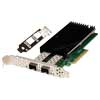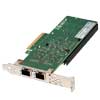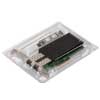Universal 25G / 10G / 1G Server Network Card, 2 SFP28 ports (Intel XXV710 Based)
You can use any SFP28, SFP+, SFP transceivers (do not need to reprogram the modules for Intel).

Universal Server Adapters with 25G SFP28, 10G SFP+ and 1G SFP (25GbE/10GbE/1GbE) connectivity
Key Features
- Dual-port 1GbE/10GbE/25GbE adapters
- PCI Express (PCIe) v3.0, 8.0 GT/s, x8 lanes
- SFP28 Connectivity
- PXE, iSCSI boot
- Network Virtualization
- IEEE 802.3by and 25GEthernet.org specification compliance
- Data Plane Development Kit (DPDK) support
- Excellent small packet performance for network appliances and Network Functions Virtualization (NFV)
- Low Profile and Full Height
Product Overview
NIC-2SFP28 is a PCIe x8 3.0 25Gbps Dual Port SFP28 Ethernet Fiber Server Adapter based on Intel XXV710 chipset, compatible with PCIe x16 slot. The server adapter can meets the demanding of next-generation data centers by providing unmatched features for both server and network virtualization, providing a reliable performance in a flexible LAN and SAN networks.
The server adapter NIC-2SFP28 delivers an excellent performance for 25GbE connectivity that is backwards compatible with 1/10GbE, making migration to a higher speed easier.
All Description 25G NIC 2xSFP28 25G/10G/1G Server Adapter :
Description
NIC-2SFP28 is a PCie x8 3.0 25Gbps Dual Port SFP28 Ethernet Fiber Server Adapter based on Intel XXV710 chipset, independently developed by Shenzhen Lianrui Electronics CO., and compatible with x4, x16 slot. The server adapter can meets the demanding of the nextgeneration data centers by providing unmatched features for both server and network virtualization, provides reliable performance in a flexible LAN and SAN networks.
The server adapter NIC-2SFP28 delivers excellent performance for 25GbE connectivity that 1s backwards compatible to 1/1OGbE, making migration to higher speeds easier.
The server adapter NIC-2SFP28 is the foundat1on for server connectivity, providing broad interoperability, critical performance optimizations, and increased agility for Telecommunications, Cloud, and Enterprise IT network solutions.
- lnteroperability - Multiple speeds and media types for broad compatibility backed by extensive testing and validation.
- Optimization - Intelligent offloads and accelerators to unlock network performance in servers with Intel® Xeon® processors.
- Agility - Both Kernel and Data Plane Development Kit (DPDK) drivers for scalabl e packet processing.
The server adapter NIC-2SFP28 delivers networking per formance across a wide range of network port speeds through inte l ligent offloads, sophisticated packet processing, and qual i ty open source drivers.
Key Features
* PCI Express (PCIe) v3.0, x8
* IEEE 802.3by and 25G Ethernet.org specification n compliance
* Network Virtualization offloads Including VXLAN, GENEVE, NVGRE, MPLS, and VXLAN-GPE with Network Service Headers (NSH)
* Intel• Ethernet Flow Director for hardware based application traffic steering
* Data Plane Development Kit (DPDK) optimized for eff1cient packet processing
* Excellent small packet performance for network appliances and Network Functions Virtualization (NFV)
* Intelligent offloads to enable high performance on servers with Intel® Xeon® Processors
* I/O vi r tualization innovations for maximum performance in a virtualized server
* Adaptive link establishment enables 1 ncreased interoperability with other 25GbE capable switches and host controllers
Flexible and Scalable I/O for Virtualized Infrastructures
Intel Virtualization Technology (Intel VT), delivers outstanding I/O performance in virtualized server environments. I/O bottlenecks are reduced through Intelligent offloads such as Virtual Machine Device Queues (VMDq) and Flexible Port Partitioning, using SR-IOV for networking traffic per Virtual Machine (VM), enabling near-native performance and VM scalability. Host-based features performance and VM scalability. Host-based features supported include:
VMDq for Emulated Path: VMDq, enables a hypervisor to represent a single network port as multiple network ports that can be assigned to the individual VMs. Traffic handling is offloaded to the network controller, delivering the benefits of port partitioning with little to no administrative overhead by the IT staff.
SR - IOV for Direct Assignment: Adapter-based isolation and switching for various virtual station Instances enables optimal CPU usage in v irtualized environments.
• With up to 128 Virtual Functions (VF)s, each VF can support a unique and separate data path for I/O- related functions within the PCI Express hierarchy.
• Use of SR-IOV with a networking device, for example, allows the bandwidth of a single port (function) to be partitioned into smaller slices that can be allocated to specific VMs or guests, via a standard interface.
Enhanced Network Virtualization Overlays (NVO)
Network virtualization has changed the way networking is done in the data center, delivering accelerations across a wide range of tunneling methods. VXLAN, GENEVE, NVGRE, MPLS and VXLAN-GPE with NSH Offloads: These stateless offloads preserve application performance for overlay networks, and the network traffic can be distributed across CPU cores, increasing network throughput.
Greater Intelligence and Performance for NFV
A combination of hardware and software acceleration features, such as Application Device Queues (ADq) and Dynamic Device Personalization (DDP), enable customizable packet filtering. The acceleration features, along with enhanced Data Plane Development Kit (DPDK), support advanced packet forwarding and high efficient packet processing for both Cloud and Network Functions Virtualization (NFV) workloads.
- ADq is a fast queuing and signaling technique for high speed I/O that improves performance and limits performance jitter.
- DDP enables a method to change the packet processing pipeline by applying a profile package to the Intel® Ethernet 700 Series Network Adapter at runtime-resulting in improvements in throughput latency and reduced CPU loads.
- DPDK provides a programming framework for Intel processors and enables faster development of high-speed data packet networking applications.
Flexible Port Partitioning (FPP)
FPP leverages the PCI-SIG SR-IOV specification Virtual controllers can be used by the Linux* host directly and/or assigned to virtual machines.
- Assign up to 63 Linux host processes or virtua l machines per port to virtual functions.
- Control the partitioning of 10 GbE bandwidth across multiple dedicated network resources, ensuring balanced QoS by giving each assigned virtual controller equal access to 10 Gbs of bandwidth.
Network administrators can also rate limit each of these services to control how much of the 10 GbE pipe is available to each process.
Advanced Traffic Steering
Intel Ethernet Flow Director (Intel Ethernet FD) is an advanced traffic steering capability built into the adapter. It consists of a large number of flow affinity filter s that direct receive packets by their flows to queues for classification, load balancing, and matching between flows and CPU cores.
Steering traffic into specific queues can eliminate context switching required within the CPU. As a result Intel Ethernet FD significantly increases the number of transactions per second and reduces latency for cloud applications like memcached.
All features 25G NIC 2xSFP28 25G/10G/1G Server Adapter :
Features
| Controller | Intel® XXV710 | |
| Transmission Medium | fiber | |
| Bracket | Low Profile Bracket and Full-height Bracket | |
| Power dissipation | Single Port 25G | 8.9W |
| Dual Port 25G | 14W | |
| Connector | 2 X SFP28 | |
| Interface Standard | PCI Express v3.0 (8.0GT/s) x8; x4,x 1 6 | |
| Data Rate Per Port | 1GbE/10GbE/25GbE | |
| PCI Express Voltage | + 12V±8%, +3.3V±8% | |
Technical Specification
| Ethernet Power Management | Yes |
| Rates | 1/10/25GbE |
| IEEE Standard I Net work topology | IEEE P802. 3by 25 Gb/s IEEE 802.11ae 10GBase-SR , 10GBase-LR , 10GBase-ER , 10GBase-ZR IEEE 802.3aq 10GBase-LRM IEEE 802.3z 1000BASE-SX , 1000BASE-LX IEEE 802.1 Qbg Virtual Bridging IEEE 802.1 Qbb Priority Flow Control IEEE 802.1az Enhanced Transmission Selection |
| PXE | Yes |
| Iscsi | Yes |
| FCoE | Yes |
| Power Management | Yes |
| SR-IOV | Yes |
| IPv4, IPv6 | Yes |
| RSS | Yes |
| jumbo frame | Yes |
| DPDK | Yes |
| NFV | Yes |
| auto-negotiation | Yes (25G<->25G, 25G<->10G, 10G<->10G, 1G<->1G) |
| Virtual Machine Device Queues (VMDq) | VXLAN, MACinUDP, NVGRE, IPinGRE |
Environment Features
| Operating Temperature | 0℃ ~ 55 ℃ (32°F to 131°F) |
| Storage Temperature | -40℃ ~ +70℃ (-40°F to 158°F) |
| Operating Relative Humidity | 35% to 90%, non condensing |
| Certificate | FCC Class A |
| LED Indicators | Link Green, 25Gb/s: Green blinking, 10Gb/s: Yellow blinking, 1Gb/s: Not bright |
Driving correlation
| Drivers Download | https://downloadcenter.intel.com/zh-cn/download/22283/-?product=95259 |
| Windows Driver Display | Intel® Ethernet Network Adapter XXV710 |
| Linux Driver Display | Intel Corporation Device 158b (rev 02) |
| Firmware Update | https://downloadcenter.inteI.com/zh-cn/downIoad/24769/ Ethernet--NVM-XL710-X710-?product=97304 |
Physical Features
| PCB Size (mm) | 159.5mm * 68.76mm * 1.6mm |
| weight (g) | 115g |
Operating system support
- Windows Server 2016 R2
- Windows Server 201 2 R2
- Windows Server 201 2
- Windows Server 2008 R2
- Windows 10
- Windows 8.1
- Windows 8
- Windows 7 x64
- Linux Stable Kernel version 2.6,3.x.4. x
- Red Hat Enterprise Linux 6.8, 7.3
- FreeBSDl03, 11
- Linux SLES 1 2 Sp2
- Vmware ESXi 6.0\65
- WinPE 3.0(2008 R2 PE).4.0(2012 R2 PE)(2012 R2 PE).6.0(2016 PE)




